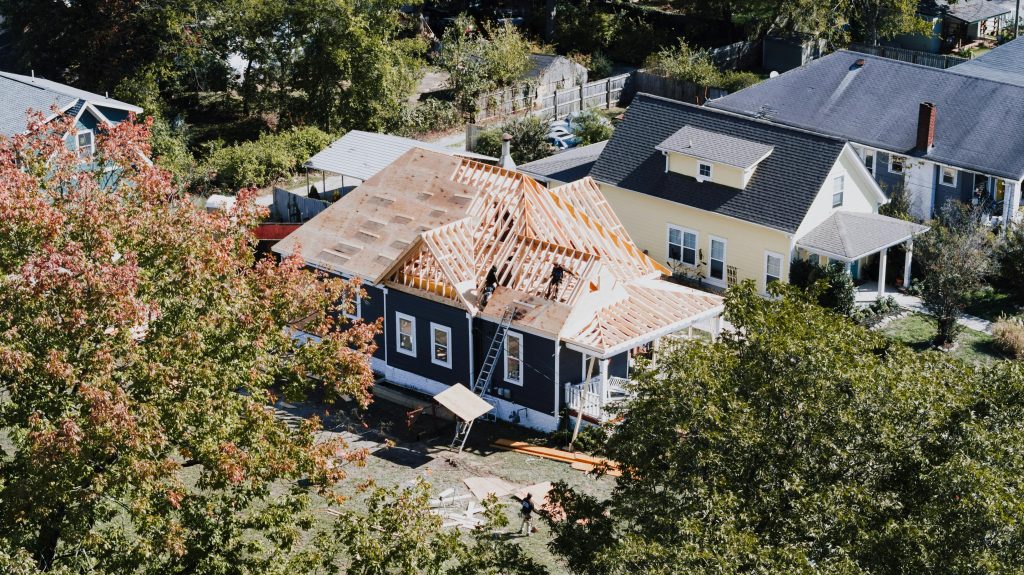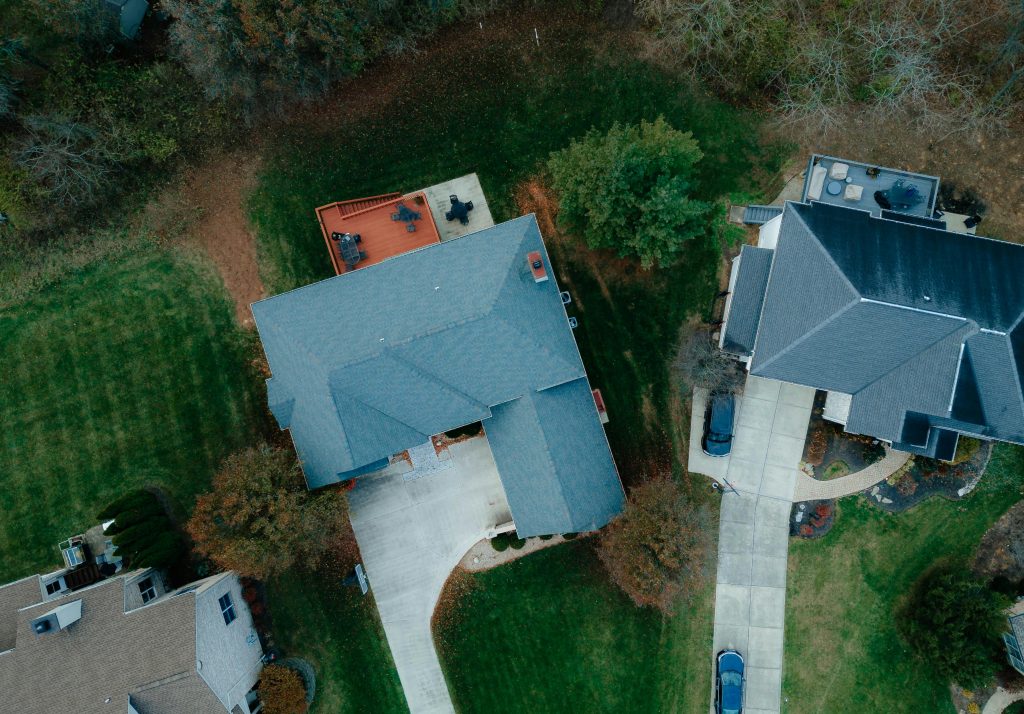Imagine standing on the rooftop of your dream home, feeling the warm sun on your face and gazing at the horizon. This perspective isn’t just about enjoying a beautiful view; it’s about the trust you’ve placed in your roof, the silent guardian against the elements. Roofing isn’t merely about shelter; it’s about durability, design, and value. If you’ve ever wondered what goes into making the perfect roof, you’re in the right place.
Roofing can sometimes seem like an overwhelming topic, full of technical jargon and complicated choices. Yet, at its core, roofing means safeguarding one of your most important investments, your home. Whether you’re building a new house or upgrading an old one, understanding roofing’s key aspects can save you money, time, and headaches.
In this ultimate roofing guide, we will dive deep into everything you need to know about roofing. From the materials that promise the longest durability to the designs that enhance your home’s curb appeal, and how all these factors contribute to your home’s overall value, this article covers it all. You’ll learn how to select roofing that not only withstands the toughest weather but also complements your personal style and adds financial worth to your property.
We’ll explore the pros and cons of different roofing types, including asphalt shingles, metal roofing, clay tiles, and eco-friendly options. You’ll discover how proper installation and maintenance can extend your roof’s lifespan, preventing costly repairs down the line. Additionally, we’ll discuss how roofing innovations are shaping modern homes, creating energy-efficient and sustainable living spaces.
So, whether you’re a homeowner embarking on a renovation or a curious enthusiast eager to learn, this guide will equip you with the knowledge to make smart roofing choices. Let’s begin your journey toward a stronger, more beautiful, and valuable roof, the cornerstone of your home’s safety and style.
Table of Contents
ToggleKey Takeaways
- More than protection: Roofing is not just about shelter — it’s about creating a durable, stylish, and high-value foundation for your home.
- Durability is key: Quality materials and professional installation ensure long-term resistance to weather, moisture, and time.
- Smart material choice: Metal, asphalt, tile, and slate roofs each offer unique advantages in longevity, aesthetics, and maintenance.
- Design enhances value: A roof’s color, texture, and shape significantly impact curb appeal and can boost property value by up to 15%.
- Energy efficiency matters: Reflective and insulated roofs reduce heat absorption, lowering energy bills and improving comfort.
- Maintenance saves money: Regular inspections and timely repairs prevent leaks, rot, and costly structural damage.
- Investment that pays off: A well-built roof increases resale value, saves on utilities, and reduces long-term expenses.
- Sustainability counts: Eco-friendly materials and proper ventilation help regulate indoor climate and minimize environmental impact.
- Harmony of function and form: Durability, design, and value work together to create roofs that protect, inspire, and endure.
Why Roofing Is More Important Than You Think
When it comes to protecting your home, roofing is the unsung hero that stands guard against the elements year-round. But what exactly is roofing, and why does it hold such a crucial role in the durability, design, and value of your property?
Understanding Roofing
Roofing refers to the materials and construction methods used to create the top covering of a building. This covering serves as a barrier between your home’s interior and external weather conditions such as rain, wind, heat, snow, and even UV rays. Without a properly installed and maintained roof, a house would be vulnerable to significant damage and discomfort.
The Vital Role of Roofing in Durability
Durability is perhaps the most critical function of roofing. A high-quality roof protects the structural integrity of your home by preventing water infiltration, which can lead to rot, mold, and weakening of the building materials. For instance, a well-constructed roof can last anywhere from 20 to 50 years, depending on the materials used, from asphalt shingles and metal to tile and slate. According to the National Roofing Contractors Association, during storms, roofs can reduce the risk of damage by 95% if they meet certain quality standards.
The longevity of your roof not only saves you money on repairs but also ensures peace of mind during extreme weather events, which are becoming more frequent due to climate change.
Roofing and Design: Elevating Aesthetic Appeal
Beyond protection, roofing plays a key role in the overall design and aesthetic of your home. The choice of materials, colors, and styles affects curb appeal dramatically, which is crucial when it comes time to sell your property. A home with a beautiful, well-maintained roof can increase its market value by up to 10-15%. Imagine a charming craftsman-style house complemented by cedar shakes or a sleek modern home topped with a metal roof that reflects sunlight , roofing styles provide not only function but a unique personality to your property.
Value-Added Benefits: Financial and Environmental
Investing in a quality roof adds significant financial value. Homes with newer, energy-efficient roofs typically sell faster and at a premium price. Moreover, many roofing materials offer energy-saving benefits. Cool roofs that reflect more sunlight reduce cooling costs, making them an eco-friendly choice that saves money over time.
A Story of Success: The Jensen Family’s Roofing Transformation
Take the example of the Jensen family, who lived in an older home that had suffered from leaky and deteriorating shingles for years. They decided to invest in a full roof replacement using durable metal roofing with a design that complemented their home’s contemporary style. Not only did the family notice lower heating and cooling bills within the first year, but their home’s value also increased significantly when they later decided to sell. The new roof was a major selling point that attracted buyers immediately, proving the lasting benefits of quality roofing.
In essence, roofing is far more than just shingles over a house , it is the critical element that ensures durability, enhances design, and adds tremendous value. Understanding this importance empowers homeowners to make smart, long-term investments in their property’s most protective and defining feature.
Tips for Ultimate Roofing: Durability, Design, and Value
✅ Choose Quality Materials: Invest in high-grade roofing materials like metal, slate, or architectural shingles to ensure long-lasting durability and enhanced aesthetic appeal.
✅ Prioritize Proper Installation: Even the best materials fail without expert installation. Hire certified roofing professionals to guarantee your roof’s performance and lifespan.
✅ Consider Roof Design and Pitch: Select a design that complements your home’s architecture and climate. Steeper pitches often facilitate better water runoff and add to durability.
✅ Invest in Regular Maintenance: Schedule annual inspections and cleanings to catch minor issues early, preventing costly repairs and extending roof life.
✅ Optimize Energy Efficiency: Use reflective roofing materials and proper insulation to reduce energy costs and improve indoor comfort.
✅ Plan for Weather Resistance: Ensure your roofing system can withstand local weather conditions, including wind, rain, snow, or intense sun exposure.
✅ Evaluate Cost vs. Longevity: Balance upfront costs with expected roof lifespan to maximize value and minimize future expenses.
✅ Enhance Curb Appeal: Choose colors and styles that complement your home’s façade, boosting overall property value and aesthetic charm.
💡 Extra tip: Install proper ventilation under your roof deck to prevent moisture buildup and reduce the risk of mold and wood rot.

Key Concepts
When we delve into the realm of roofing, particularly under the scope of “The Ultimate Roofing Guide: Durability, Design, and Value,” we are engaging with a concept that is as foundational as the very shelter it provides. Roofing is not merely a protective barrier atop a structure; it is a dynamic interplay between material science, architectural vision, and longevity, all converging to create enduring value.
The Essence of Durability in Roofing
Durability stands as the cornerstone of roofing. Imagine the roof as the skin of a living organism, constantly exposed to the elements, it must withstand heat, cold, moisture, UV radiation, and the relentless battering of wind and debris. Durability is not a mere statistic; it manifests as resilience over time. It speaks to a roof’s ability to endure without succumbing to wear, cracks, or deterioration.
Think of durability like a sturdy shield forged in the fires of quality craftsmanship and robust materials. A roof’s ability to maintain structural integrity over decades, often exceeding 20-30 years, hinges on this durability. It is the difference between a roof that weathers storms gracefully and one that falters at the first gust of wind.
Design as an Architectural Dialogue
Roofing design is where function and aesthetics engage in an elegant dance. It’s much like storytelling in architecture, each roof tells a unique tale shaped by the building’s cultural context, climatic conditions, and the homeowner’s personality. A pitch, for instance, isn’t just a slope; it’s a strategic decision impacting rainwater runoff and snow load management.
Design in roofing transcends the visual; it’s an engineering philosophy. Materials such as slate, metal, or asphalt shingles lend distinct textures and colors, channeling both mood and atmosphere. A modern flat roof might suggest sleek minimalism, whereas a traditional gabled roof evokes familiarity and warmth. Much like music sets the tone for a play, the roofing design sets the tone for the entire structure beneath.
The Intrinsic Value Embedded in Roofing
Value in roofing is a multifaceted gem, reflecting more than the initial cost. It encompasses the long-term financial benefits obtained through energy efficiency, minimal maintenance, and enhanced property appeal. Imagine a well-designed and durable roof as a silent investment, one that quietly protects and augments the home’s worth over years.
This value can be illustrated as an invisible thread weaving through daily life, a shield that reduces heating or cooling expenses by enabling better insulation, a canvas that boosts curb appeal and hence market value, and a guard that spares homeowners from costly repairs caused by leaks or structural failures. It is this enduring, compounded worth that transforms roofing from a mere construction necessity into an asset.
Interconnection of Durability, Design, and Value
These three pillars, durability, design, and value, aren’t isolated ideas but components of a seamless ecosystem. They harmonize to craft roofing solutions that serve both practical needs and aspirational goals. Durability ensures performance over time; design frames that performance within an artistic and contextual narrative; value translates these elements into real-world benefits.
Imagine each roofing project as a symphony: durability provides the steady rhythm, design the melody, and value the emotional resonance that lingers long after the final note. A roof without durability falters early, a design without substance feels hollow, and value without thoughtful execution is ephemeral.
Materiality as the Language of Roofing
Materials form the vocabulary through which roofing communicates durability and design. Each material brings with it unique qualities, metal offers sleekness and longevity akin to a finely crafted instrument; clay tiles echo traditional artisanry reminiscent of a timeless painting; synthetic membranes speak to innovation as a modern sculpture would.
Understanding roofing means appreciating this language. Materials do not merely coat the structure; they interact with light, weather, and the human senses, influencing how the roof ages, how it performs, and how it is perceived.
Environmental Considerations: The Silent Partner
Underlying durability, design, and value is an ever-present theme in contemporary roofing, the environmental context. Roofing choices are no longer isolated from ecological impact. They form part of a broader dialogue about sustainability and environmental stewardship.
A roof acts as a mediator between a home and its surroundings, regulating temperature and managing water runoff. The design and material choices either contribute to or reduce a building’s ecological footprint, making roofing a subtle participant in environmental harmony or discord.
By weaving together these key concepts, we begin to see roofing not simply as an architectural necessity but as a profound convergence of science, artistry, and practical wisdom. Roofing, in its ultimate form, is a testament to human ingenuity, crafting enduring shelter that resonates deeply with both the environment and the spirit of home.
Frequently Asked Questions (FAQs) about Roofing
❓ What factors affect the durability of a roofing system?
The durability of roofing depends on several factors including the roofing materials used, installation quality, local climate, and maintenance practices. For example, metal roofs typically last longer than asphalt shingles, and proper installation ensures the roof withstands harsh weather. Regular inspections and timely repairs also extend a roof’s lifespan.
❓ How does roofing design impact the overall value of a home?
Roofing design significantly influences a home’s curb appeal and market value. A well-designed roof that complements the architectural style adds aesthetic value and can attract potential buyers. Additionally, energy-efficient roofing designs reduce utility costs, enhancing the home’s long-term value.
❓ What are the best roofing materials for long-term value?
Materials such as metal, slate, and tile are known for their longevity and minimal maintenance, offering great long-term value. Asphalt shingles are more affordable upfront but may need replacement sooner. Choosing the right material depends on budget, climate, and the desired lifespan of the roof.
❓ Can I improve my roof’s durability without replacing it?
Yes, regular maintenance like cleaning gutters, sealing leaks, and replacing damaged shingles can improve durability. Applying roof coatings can also protect against UV rays and water damage. However, if the roof is significantly deteriorated, replacement might be the better option.
❓ How important is professional installation for roofing?
Professional installation is crucial for maximizing roof durability and performance. Experts ensure materials are correctly applied, flashing is sealed, and ventilation is adequate, preventing common issues like leaks and structural damage. DIY roofing can lead to costly problems and reduced roof lifespan.


